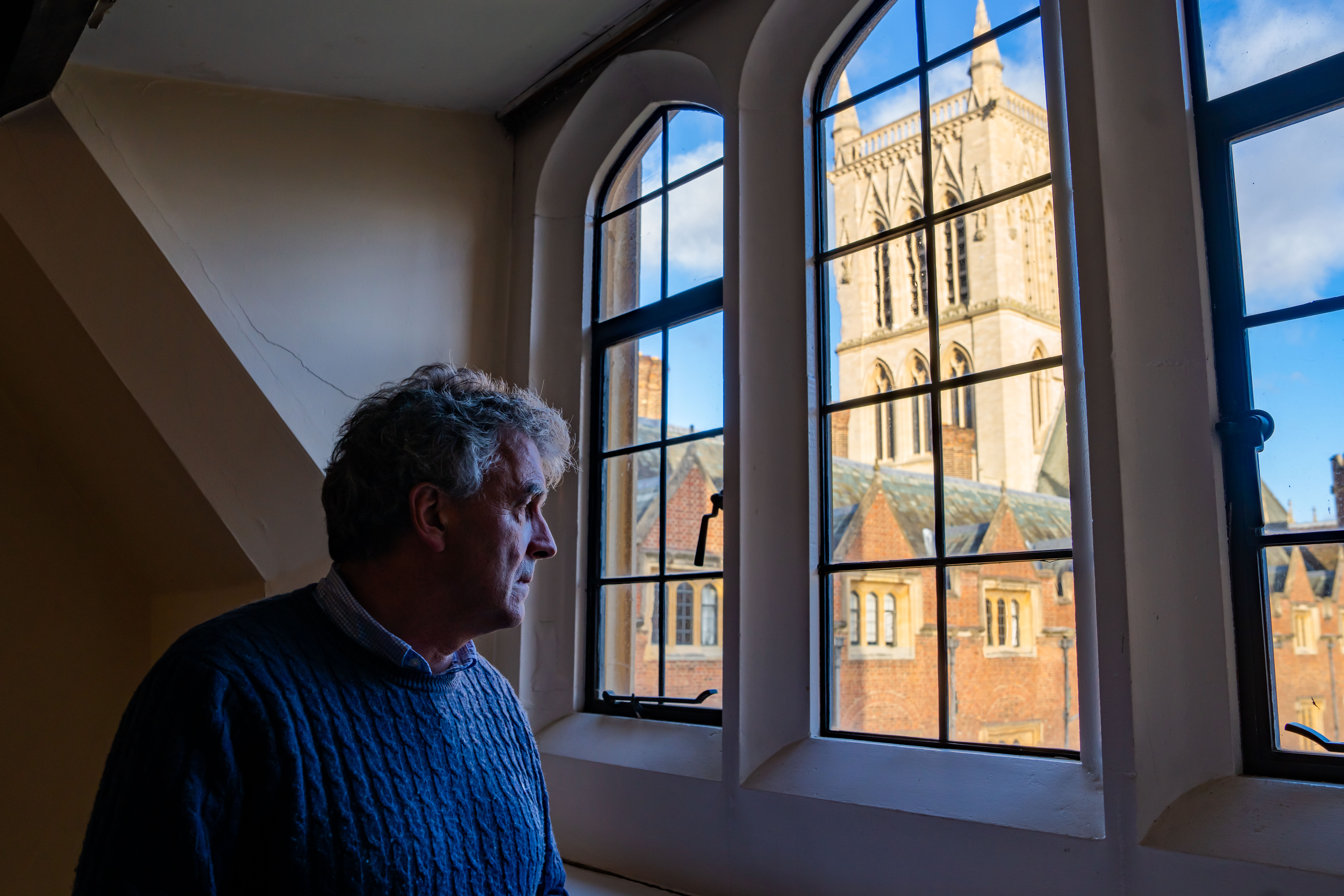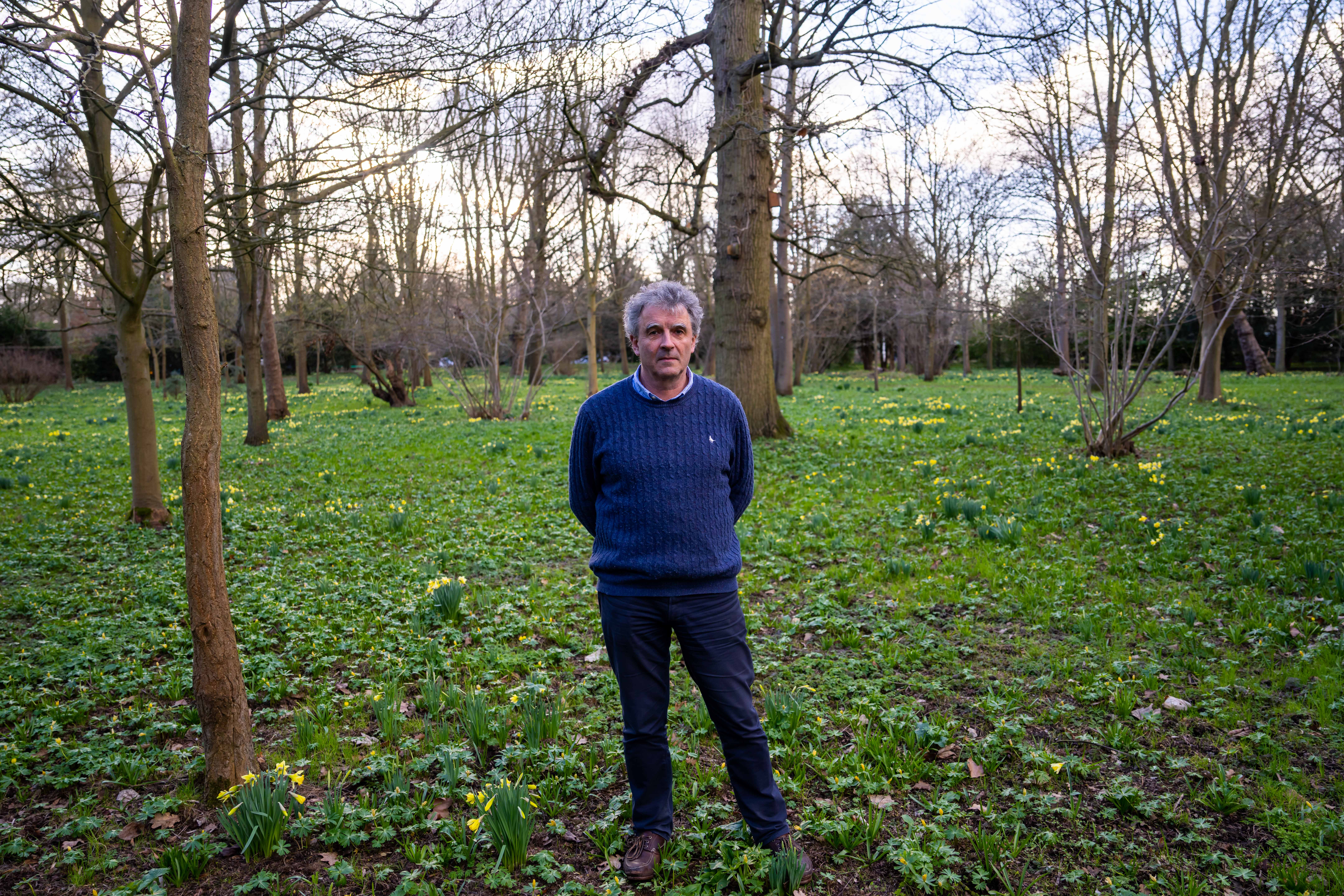Not just hot air: bringing sustainable heating to a 500-year-old College
“We’re carrying out research on the design and operation of low carbon and energy efficient heating systems for College”
Energy is one of the key issues of our age. How we eat, how we keep ourselves and our buildings warm, how we counter the destructive effects of carbon emissions on our climate as we transition to cleaner energy. St John’s, like the wider University, is grappling with these unprecedented questions, in our world-leading research but also in our day-to-day processes as a place of study and a residential community. In the first of a new series of articles, we look at the work being done to move the College towards energy-efficient heating and decarbonisation as part of our green manifesto.
“The doors leak, and so do the windows,” says Professor Andy Woods, sitting in his St John’s study beside a gas fire that is, despite the chills of February, turned firmly off. “These are historic buildings: they are poorly insulated and take a lot of heating, so they are very challenging to decarbonise. Also, Cripps [John’s’ 1960s Modernist accommodation block] has a huge amount of glass.”
Fortunately, Andy – chair of the College’s Energy Transition Working Group – is precisely the right person to take on that challenge. The St John’s Fellow is Director of the Institute for Energy and Environmental Flows (IEEF) established in the University of Cambridge in 2000 and originally known as the BP Institute. IEEF researchers work with academic and industrial collaborators from around the world, using fluid mechanics, thermodynamics and surface science to help with some of the major challenges of decarbonisation, including geological carbon storage, geothermal heat storage, energy efficient building design, and superfast battery charging.
The Institute is at the forefront of global energy transition research, but through the St John’s project, Andy and his team can also apply their expertise locally in the complicated context of a 500-year-old College estate on the banks of the Cam in the fast-growing, energy-hungry city of Cambridge. “In these challenging buildings,” he says, “there is not necessarily a template for how you go about doing this. We’re trying to understand what can be done, and comparing different approaches. We’re carrying out research on the design and operation of low carbon and energy efficient heating systems for College, looking at the challenges of deploying such systems in important historic buildings.” With the College as a test bed, the hope is its experience can be shared as widely as possible to help others in the UK and beyond.

To achieve the agreed goal of reducing the carbon emissions of the College, transforming the heating was the clear first step. On the St John’s estate, over 80% of carbon emissions come from burning natural gas to heat the buildings and provide hot water. There are no fewer than five giant boiler systems on the main College site, while student hostels (mainly a collection of individual houses) have their own independent heating systems. Currently, the College uses about 12.6 gigawatt hours of gas annually for heating its buildings and water, at a cost of approximately £882,000 per year.
“If you can remove the natural gas, then you’re not getting those emissions,” Andy says. “But you have to replace the gas with something. So, you can put heat pumps in: they take thermal energy from one place, raise the temperature of this energy and use it to drive the central heating. But you need electricity to run the heat pumps. One unit of electrical power in the pump can transfer three units of heat to the radiators. So, we asked, can we use heat pumps in College?”
The working group developed models to explore options including high and low temperature heat pumps, powered by air source or ground source heat supply, and identified the costs, practicality and efficiency of each. The analysis concluded that replacing gas boilers with a series of heat pumps would cut the College’s carbon emissions by at least half, and possibly by as much as 55%. The pumps would not remove emissions completely because the electricity that powers them is drawn from the national grid, and – while the proportion of electricity generated from renewable sources is growing – gas-fired power stations still play a role. In the longer term, as the national electricity supply becomes progressively more decarbonised, so will the College.
The next step is to move from calculations to real-life trials. An air source heat pump will shortly be commissioned to power two staircases in Cripps, and further heat pump systems will be introduced into some of the houses on St John’s Road. If successful, the provisional longer-term plan, which will cost an estimated £20 million plus the cost of supplying new electricity, will see high temperature pumps used to heat the buildings of the main College estate (many of them old and listed in recognition of their architectural and historic significance), while the newer hostels will be fitted with lower temperature versions.
While the heat pumps will make the most dramatic single impact on its emissions, there are other important steps the College will also take, Andy says. “We have a three-point plan, and heat pumps are only the first part. We also need to have more precise control of energy use. We are developing prototypes for a digital system that will allow us greater control and save money.” There is scope, for example, for a smart system that would turn off radiators remotely when students leave for the Christmas holiday, and for introducing temperature and motion sensors to enable heating to switch off automatically in individual rooms if a window is opened or the room is unoccupied for a long period.
“I’m very optimistic we can trial many approaches and technologies and make a big change. It’s a really exciting time”

The third element in the energy saving plan is the upgrading of the fabric of the College buildings to improve insulation and reduce heating demand. The process is effective, but expensive: increasing the insulation in two student houses alone cost more than £100,000. “It reduced the gas bill by 50% but the payback time is very long,” Andy notes.
If the heat pump trials prove successful and the approach is extended College-wide, there will be more hurdles to cross. A test programme will be needed to decide on the balance between air source and ground source heat for the main College heat pumps, and locations will need to be found for the technology needed to operate either system. Air source pumps require heat exchangers; heating the whole College would need an area of many hundreds of square meters. Roofs of newer buildings could potentially be used, but there will be design challenges to address. To use ground source heat, meanwhile, the College would need many hundreds of boreholes, each up to 150m deep. The holes could be drilled on the College backs, but space is limited and to work effectively they cannot be placed too close together.
A third – and intriguing – potential heat source in winter is the River Cam, either through heat exchangers within the flow or by extracting water, cooling it and returning it to the river. St John’s is collaborating with the other seven Colleges sited directly on the river to scope out the possibilities of the scheme, and work has been underway for the past six months to test the river flow and temperature. The project seems viable, but – even if the relevant permissions are granted – the energy produced would be shared between the Colleges along the Cam and could only contribute a portion of John’s’ overall demand.
Even once the technical challenges of designing and installing heat pumps have been overcome, a wider structural issue remains: Cambridge has an electricity capacity problem. There is, for now, too little electricity supplied to a city with growing demand, including electric vehicle charging. “You bump up against the infrastructure of what is actually possible,” Andy says. “If many of the central Colleges were to install heat pump systems, we would need tens of megawatts of additional electricity supply, as well as the increasing demand from the university. There is competition for resources. Until the grid builds up and there is more supply, it’s going to be hard to do this.” Even once there is enough electricity, the supply of skilled plumbers and engineers to install the new system may not be able to keep pace with demand.
The obstacles in decarbonising a College, clearly, are many, but developing strategies to overcome the various problems, Andy adds, is the point. “Publishing our approach to decarbonise such important and historic buildings in the academic literature could be very valuable in helping inform strategies on decarbonisation of other challenging or historic buildings and institutions. There’s a wide variety of building types in St John’s and there is not a one-size-fits-all solution.” The working group has already shared its findings with building estate managers of other colleges and plans shortly to issue a publicly available report on its progress.
The John’s experiment is small in global terms, but great in its potential to act as a beacon for others. One by one, the many technical and other challenges can be overcome, using Cambridge expertise, Andy says. “I’m very optimistic we can trial many approaches and technologies and make a big change. It’s a really exciting time.”
Published 1/3/2023